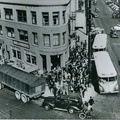Read Part 21 >>
THE FIGHT FOR EQUAL RIGHTS
While the Japanese community turned inward for sustenance and support, about the swirled a constant barrage of accusations which the Issei could not ignore. Racist arguments called to “Restrict backward races,” and “Keep United States and Canada White Man’s countries.” In 1905, newspaper headlines blared: “JAPANESE A MENACE TO AMERICAN WOMEN.” California State Senator James D. Phelan warned, “The rats are in the granary. They have gotten in under the door and they are breeding with alarming rapidity. If this is not checked now, it means the end of the white race in California, subdivision of American institutions and the end of our Western civilization.”
The Japanese community reacted to the charges of the anti-Japanese movement by forming larger organizations such as the Japanese Association of America that encompasses all locals in California, Nevada, Utah, Colorado, and Arizona. One of its functions was to implement the Gentleman’s Agreement by processing certificates which determined whether a person was bona fide resident in America. Another purpose of the centralized body was to present a united strategy in counteracting the anti-Japanese movement.
In a memorial addressed to President Woodrow Wilson on his 1919 visit to San Francisco, the Japanese Association of America discussed the changes levied against the Japanese: The Japanese nation is characterized by industry and perseverance, so naturally the Japanese who are here possess the power and endurance and the habit of industry. But it appears rather strange that Americans complain of these facts, for they themselves take pride in these very characteristics.1
In a fruitless attempt to avoid further white resentment, the Japanese Association reported:
We are advising them (the farmers) as best we know how, not to work so hard as to cause their neighbors to criticize them, and to create some leisure for self-development.... We tried to import to our fellow countrymen elementary facts of American civilization so that they could better fit themselves for American life. We tried to teach them that assimilation was the first step in their success.2
On the Mainland, the Issei attempted to defend themselves from anti-Japanese charges by wearing American clothes and conforming their physical living environment to meet American standards. In Hawaii, where Japanese comprised over 40 percent of the population between 1910-1920, men and women took much longer to discard their kimonos for Western-style clothes. However, with pressure from the Japanese Association under the sponsorship of the Japanese Consulate, Issei men and women gradually stopped wearing kimono on the streets.3
In an effort to teach Issei mothers about American childcare practices, the Japanese Association in San Francisco published in 1924, A Guide on Child Care for Expectant Mothers which imparted general childcare information. The guide advised Issei parents to “study the conditions, peoples, customs, and habits of America and use them as a guide in disciplining.” The Association warned that “It would not be beneficial for the child to bring him/her up as you would in Japan.”4
A deliberate attempt was made to not speak Japanese loudly in public places and to avoid visible and conspicuous displays of Japanese articles or signs written in Japanese. Issei were urged to observe the Sabbath as a day of rest and to commemorate holidays such as Thanksgiving, Independence Day and Christmas.
With tiny voices
Whispering in Japanese
We ride the bus.5
Issei women enrolled in Americanization classes which taught first aid, embroidery, tatting, crocheting, and knitting. The English language classes were by far the greatest in demand.
To demonstrate their loyalty, Issei went out in droves to purchase war bonds during World War I. In California, they bought a total of $2,648,800 in five liberty loans.6
Moral reform campaigns were conducted throughout the West Coast to eradicate gambling and prostitution from the Japanese communities. Gambling houses were boycotted and men who were involved in illicit activities were deported. Local Japanese associations held enormous social control over Japanese immigrants by denying proof of residency certificates to those who were considered to behave in a manner that was detrimental to the Japanese community.
Some in the Japanese immigrant community believed the Issei had to go beyond just changing external appearances and adopt American Christian religious values and American democratic principles. “Because of the social climate, what is called the ‘beika-movement’ became very popular among the Japanese,” explained Juhei Kono. “By beika I mean ‘Americanization”.... Becoming a Christian was one way of beika, but we also emphasized appreciation of American life.”7
Notes:
1. California and the Oriental (1920), pp. 203-15; “Letter of Warning of Sei Fujii,” Major Document 207, SRR Papers, as quoted in John Modell, The Economics and Politics of Racial Accommodation: The Japanese of Los Angeles 1900-1942 (Chicago, 1977), p. 12.
2. Ibid, p. 12.
3. Michiye Makino et al. (Eds.), Life of Kinzaburo Makino, p. 40.
4. Japanese Association of America, A Guide on Child Care for Expectant Mothers (San Francisco, 1924), translated from Japanese to English by Alice Niiya.
5. Fusako, Ito, Issei, p. 99.
6. John Modell, The Economics and Politics of Racial Accommodation: The Japanese of Los Angeles 1900-1942, pp. 84-85.
7. Juhei Kono interview, Sanasohn, The Issei, pp. 68-69.
*Issei Pioneers: Hawai‘i and the Mainland, 1885-1924 is the catalogue accompanying the National Museum’s inaugural exhibition. Using artifacts from the National Museum’s collection to tell the story of the courageous “Issei Pioneers,” the catalogue focuses on the early immigration and settlement years. To order the catalogue >>
© 1992 Japanese American National Museum





